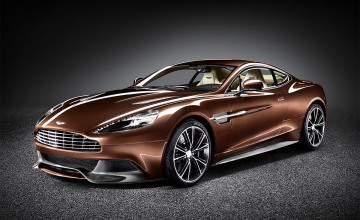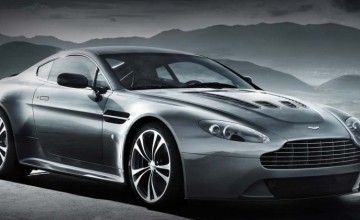The Aston Martin is the English alternative to the Bugatti and Ferrari. The company was founded in 1913 by mechanical engineer Robert Bamford and wealthy Lionel Martin. The two had met in 1905 as members of a cycling club and progressed during the Edwardian era to classic trials and hill climbs using the Singer sports car.
Bamford thought he could improve the car, and soon began to build cars which took the Aston Martin name (from Martin’s exploits at the Aston Clinton hill climb in Buckinghamshire).
However, the partnership was not to last and Martin bought out Bamford in 1922. Soon the company being asked for replicas, but being English, they didn’t like to make a profit from their friends and the firm nearly went bust in 1925. It was saved by Lord Charnwood and Hon. John Benson, who appointed Italian born Augustus Cesari Bertelli as Managing Director.
The company built the Ulster between 1934 and 1935 which had an in line 4 cylinder 1495cc, single overhead camshaft which featured an advanced dry sump engine. It produced 80bhp at 5250rpm, had a top speed of 100mph, and named after the Ulster TT road race. The Ulster was the best performing of the pre war Astons.
Following the war, many manufacturers were suffering financial difficulties. David Brown (famous for tractors) acquired Aston Martin in 1947 for 20,500, and in 1948, purchased Lagonda for 52,000.
He made something of a false start with the underpowered four cylinder Aston Martin DB1 in 1948. This was the start of a series of DB cars.
16 February 1972 was a black day for Aston Martin enthusiasts, who will always outnumber owners. David Brown sold the firm to Company Developments Limited, a minor league Midlands based asset stripper, who were soon to realise that luxury car sales were a very sensitive bellwether of a fragile economy.
The 1970s were just about to happen to Britain. There was the oil shock, the stock market collapse, the three-day week and Ted Heath and the winter of discontent.
Given what was to happen 15 years later, the brief encounter between Henry Ford II and a small group of businessmen, which took place on the eve of the Company Developments takeover, is revealing.
The small syndicate whose idea was that Ford should buy the Aston Martin marque, and the cars marketed in America with Ford engines and transmissions had approached Ford. It was the re-emergence of the theme set by Carroll Shelby years before, and which had led to the Sunbeam Tiger, the AC Cobra and a host of imitators and might have beens. Ford said no, and Company Developments acquired Aston Martin.
It was a pity, for at least the Ford scheme had a business plan behind it that looked to car sales as its mainspring as opposed to a situation that, when the dust settled, left the firm no better off, in receivership and minus assorted other assets.
There were few differences between the DBSV8 and its successor the AMV8, but the most significant one was probably the price.
The new car was 9000, and for those who were trying to justify buying one or trying hard to hold on to their old one in the face of economic stagnation and a stock market in the grip of a nervous collapse. This, of course, was even before the oil price rise.
When that happened, sales imploded, and when the bean counters moved in, redundancies and economies were made, and as a result, the quality control side of the business, always a source of pride to the firm, weakened rapidly.
The clear lack of capital in the face of a sales crisis put AML Limited in a difficult situation. The sports ground was sold hurriedly at a knockdown price and within a year of the sale by David Brown, the firm was in the throes of a major crisis.
This was important in two ways, firstly, the oil shock had a direct effect on the marque, and secondly, the fallout from the financial crash meant that second hand prices for Aston Martins plummeted and many fell into the hands of those who could not, or would not maintain them properly.
When oil changes were missed, and servicing skimped and cheap substitute parts were used, it does not take long for a beautiful, agile and powerful car to turn into a smoke belching clunker.
Having said that, it is also the case that the vast increase in values that was ushered in by the 1980s also triggered some heavy expenditure on restoration. The flight away from financial assets in the wake of the 1987 stock market crash had the same effect on classic cars as it did on property, there was a spike upwards in values of anything with a remotely historic pedigree, and Aston Martins were some of the biggest gainers.
Being fair to Company Developments, they were not entirely paralysed by the crisis. Their attempt to reintroduce the Lagonda marque, on the same basis as the Rapide, by stretching a V8 chassis and rebodying it, was not a success, but it was at least something, even if it smacked of boardroom panic.
Despite the cars appreciation in value, the company was often financially troubled. In 1972, it was sold to a company called Company Developments Ltd, backed by a Birmingham based consortium and chaired by William Wilson. The company was then resold in 1975 to Peter Sprague and George Minden. The new owners pushed the company into modernising its line.
In 1980, Aston Martin had plans to buy MG, which did not materialise.
As worldwide sales of Astons shrank to three per week, Alan Curtis (chairman) together with fellow shareholders Sprague and Minden, had almost chosen to shut down the production and concentrate on service and restoration. Curtis attended the 1980 Pace sponsored Stirling Moss benefit day at Brands Hatch and met Victor Gauntlett.
Gauntlett bought a 12.5% stake in the company for 500,000 with Tim Hearley of CH Industrials taking a similar share. They then took over 50/50 ownership at the beginning of 1981, with Gauntlett as executive chairman. He also led the sales team, and after some development and a lot of publicity, was able to sell with success the Aston Martin Lagonda to Persian Gulf States.
They continued sponsoring racing events and all Aston Martin Owners Clubs events.
As trading became tighter in the petroleum market, and Aston required more time and money, Gauntlett agreed to sell his company ‘Pace’ to the Kuwait Investment Office in September 1983. He also agreed to sell his share holding to Peter Livanos.
September 1987 saw Ford take a share holding in the company. They placed Aston in the Premier Automotive Group, and substantially invested in new manufacturing and quickly ramped up production. In 1994, they opened a new factory at Banbury Road in Bloxham.
In 2006, under mounting pressure, an internal review of costs and realisable value on investment led Ford to consider divesting itself of parts of its Premier Automotive Group. After suggestions of selling Jaguar, Land Rover or Volvo, Ford decided to sell Aston by auction. At the end of August 2006, Ford announced that it would be willing to sell all or part of Aston.
The first round of the auction closed on 30 November 2006. On 12 March 2007, a consortium led by Prodrive chairman David Richards purchased Aston for 475m/$848m. Prodrive had no financial involvement in the deal, and Ford kept a stake in the company valued at 40m/$70m. The consortium also consisted of John Sinders and two Kuwaiti investment companies.
On 19 July 2007, the last car, a Vanquish S was produced at Newport Pagnell. Nearly 13000 cars had been produced their and all production was concentrated at Gaydon.
In January 2009, Aston announced that it would be entering the 2009 Le Mans 24 Hours race as a factory team in the LMP1 division. The company finished 13th.



